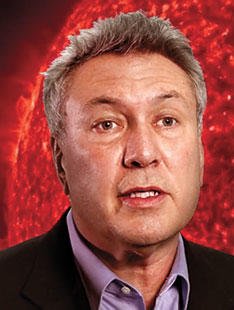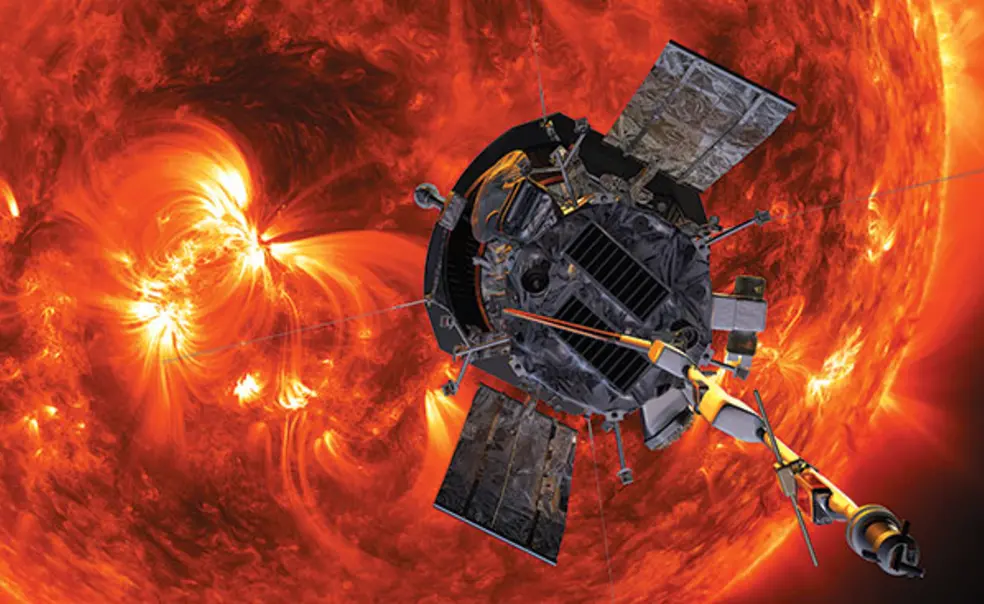Astrophysical Sciences: Looking at the Sun
Pioneering solar experiments could reveal ‘secrets of the universe’
On Nov. 5, a pair of instruments running experiments led by Princeton professor David McComas made a record-breaking pass through the sun’s atmosphere. That day, the Parker Solar Probe, carrying McComas’ instruments, passed within 15 million miles of the sun, nearly twice as close as any spacecraft before it. McComas’ instruments, together called the Integrated Science Investigation of the Sun (ISʘIS; pronounced EE-sys), spent the record-breaking fly-by collecting and measuring high-energy particles from the corona, the extremely hot outer atmosphere of the sun.
The probe, which launched Aug. 12, is due to swoop through the corona more than 20 times over the next seven years; with each pass, ISʘIS will inventory the particles zipping out from the sun, whose tumultuous physics have effects from Earth to the solar system’s edge. “This is an unexplored region of space,” says McComas, professor of astrophysical sciences and vice president for the Princeton Plasma Physics Laboratory.

While ISʘIS (ʘ is an astronomical symbol for the sun) studies the sun up close, McComas is leading another mission to understand how the sun affects the farthest reaches of our solar system: This summer, the $500 million Interstellar Mapping and Acceleration Probe (IMAP) with McComas as principal investigator was selected by NASA for development and a 2024 launch. IMAP will orbit just sunward of Earth, pointing its sensors toward the edge of interstellar space. On this periphery, the solar wind — a million-mile-per-hour stream of charged particles ushering forth from the corona in all directions — collides with the sparse ionized gas of interstellar space. This collision forms a turbulent magnetic bubble around our solar system, absorbing cosmic radiation and neutralizing many of the charged particles that do make it through.
By charting the neutral particles that originate in this boundary region and interstellar space, instruments on IMAP will chart the edge of the solar system. Together, the two probes represent the next steps in understanding the effects of the sun’s tempestuous physics for life on Earth and conditions on other planets.
The Parker Solar Probe is humanity’s first venture into the corona, and the November fly-by, through the corona and out toward the orbit of Venus, is just the beginning. Every few orbits, when the craft passes Venus, that planet’s gravity will tighten the probe’s orbit, eventually bringing ISʘIS and the other instrumentation onboard within 4 million miles of the sun — seven times closer than the previous record.
This inside view will begin to unlock some mysteries about the corona, from its remarkable heat — it is, inexplicably, up to 200 times hotter than the sun’s surface — to the source of the solar wind and other more threatening phenomena. One such threat is coronal mass ejections, powerful eruptions of plasma that hurtle out through the solar system. When such eruptions collide with Earth’s magnetic field, they can damage satellites and other high-tech systems, or even threaten Earth-bound infrastructure. A March 1989 ejection caused a nine-hour blackout across much of Quebec, and the most powerful events — such as one that hit Earth in 1859, or another that missed us in 2012 — could disrupt enough systems to cause global catastrophe.
“The impact on the global economy, or on communications and even food distribution, could be horrendous,” says McComas. With our current lack of knowledge about the corona, Earth has erratic warnings, coming only about 30 minutes before the plasma hits. Learning to predict a coronal mass ejection even a day ahead of time, says McComas, would allow power grids, satellites, and other susceptible technology to be set into safer configurations for the duration of the threat. That sort of prediction would “be extremely valuable for humanity,” he says.
The probe had a long journey before the launch. A similar solar orbiter was first proposed in the 1990s, but McComas and others faced budget cuts, committees, and drastic changes to the orbital plan. The original trajectory, proposed by a NASA committee McComas chaired in 2005, would have used Jupiter’s gravity to swoop even closer to the sun, requiring prohibitively expensive heat shielding. McComas’ committee reconvened in 2008 to propose the probe’s current trajectory, which requires a still-formidable 4.5-inch carbon shield to protect the probe — representing a $1.5 billion investment for NASA and some 4 million hours of development and production — from 2,500-degree heat. The new orbit means that, from their perch behind the heat shield, ISʘIS’ two instruments — one collecting very fast electrons and ions, and the other collecting even faster ones — will have ample opportunity to sample particles from many different coronal conditions, untangling layer by layer how the solar wind and coronal mass ejections are generated. “By having many fly-bys, you basically are ensured to see all these different types of solar phenomena multiple times,” says McComas.
As thrilled as he is to learn from ISʘIS’ observations, McComas is equally eager for IMAP to reveal features of the turbulent interstellar boundary, which is as enigmatic as the corona. For example, when another mission McComas is leading, called IBEX, discovered a ring around the interstellar boundary producing many more neutrally charged particles than elsewhere on the boundary, no fewer than 13 different theories cropped up to explain it. IMAP’s high-resolution map will help pare down these and other theories.
McComas says he’s “incredibly excited” for both missions: “It’s an awesome responsibility and an awesome opportunity to make a huge difference in our understanding of the secrets of the universe and the world around us.”












No responses yet